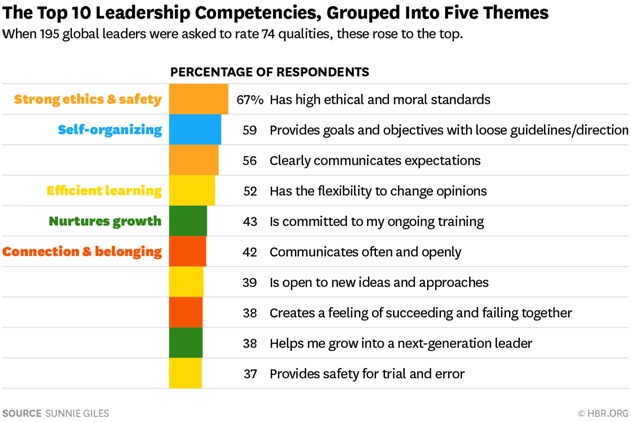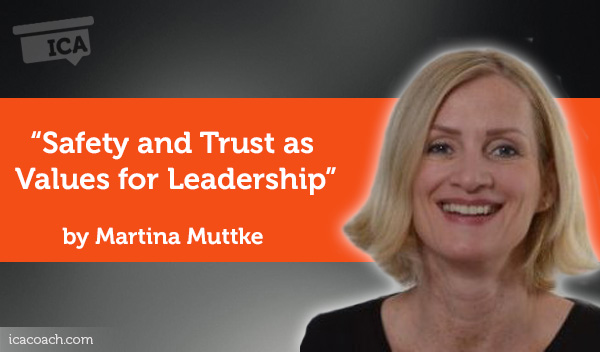Research Paper By Martina Muttke
(Executive Coach, SWITZERLAND)
Leadership today is still- and first of all, about creating a safe and trusting environment. Leadership means taking care of others.
Psychological safety is often confused with other concepts such as trust and psychological mindfulness. The primary differences between psychological safety and trust, are that psychological safety focuses on a belief about a group norm, but trust focuses on a belief that one person has about another. Also, psychological safety is defined by how group members think they are viewed by others in the group, but trust is defined by how one views another (Edmondson et al.)
Without safety and trust, you can’t lead effectively, and your teams cannot reach their full potential.
Despite what we believe about the necessities of having certain skills as a leader, the reality shows “soft” items are in the forefront of the expectations employees have for their leaders.
Sunnie Giles, President of Quantum Leadership Group, completed a study with 195 leaders in 15 countries over 30 global organizations. Participants were asked to choose the 15 most important leadership competencies from a list of 74.
67% selected as one of the most important “the leader demonstrates strong ethics and provides a sense of safety”.
On the top of the list were also the following leadership qualities: “nurtures growth” and “provides a sense of connection and belonging”

Also, when leaders clearly communicate their expectations, they make sure there message is understood. In a safe environment employees can relax, invoking the brain’s higher capacity for social engagement, innovation, creativity, and ambition.
Safety avoids the Amygdala Highjack
Neuroscience descibes the responses of our brain to stimuli in safe and unsafe environments, exploring the much talked about “Amygdala Highjack”:
The amygdala hijack is an immediate, overwhelming emotional response with a later realization that the response was inappropriately strong given the trigger.
Daniel Goleman coined the term based on the work of neuroscientist Joseph LeDoux, which demonstrated that some emotional information travels directly from the thalamus to the amygdala without engaging the neocortex, or higher brain regions. This causes a strong emotional response that precedes more rational thought.
What happens when our Amygdala reacts like that?
When the amygdala, registers a threat to our safety, arteries harden and thicken to handle an increased blood flow to our limbs in preparation for a spontaneous response.
In this state, we lose access to the social engagement system of the limbic brain and the executive function of the prefrontal cortex, inhibiting creativity and the drive for excellence.
Under such stress, when our amygdala is switched off, we are seriously overreacting to an event in our life: we lose control of our behavior and show the basic survival behavior of fight, flight or freeze.
From a neuroscience perspective therefore, making sure that people feel safe on a deep level should be job #1 for leaders.
The importance of creating trust
One of main purposes of leadership is to build an environment of trust and safety. This can be imagined as building the concrete foundation for a house: We invest energy, money and time in building a house, making it look beautiful and attractive. But if the foundation is not very solid and stable, i fit is not safe, the house will deteriorate in ‘bad weather’. The same applies to leadership.
The most effective leaders share a lot of characteristics, but the most important is their ability to inspire trust. Trust is essential to an effective team, as it provides a sense of safety. It can be build by encouraging and nurturing relationships and communication.
With a solid foundation of trust, team members will act freely and without fear, and they’ll be more willing to take risks, move outside their comfort zones, and explore new ideas. They’ll more readily share information, feeling confident that their leader and other members of their team have their best interests in mind .
Tim Brown, CEO from IDEO describes the “gardener” as one of the roles a leader needs to take: a gardener has to nurture culture, nurture environment, and nurture circumstances. The gardener creates the ground and sets the stage for people to be comfortable, innovative, productive.
How to create a safe environment?
A safe space or environment is a space of no judgment. All thoughts and questions are equally important- members can think aloud, have incomplete ideas, and can ask stupid questions (Maxine Attong).
A safe space of trust and positive culture can have different functions: It can becomes a think tank, a place to brainstorm and generate ideas, it can be used as a garbage bin to dispose of unwanted burdens that prevent members from focusing on the task at hand. At other times, the space offers a cocoon that protects and nurtures thoughts and dreams. Whatever the need, in the safe space, leaders provide team members with the necessary support.
A safe space promotes a culture in which employees can question the status quo, challenge authority, and take risks and fail, without jeopardizing their careers.
In order to create a safe space, leaders can work with structures for support: people do thrive with a helpful set of structures around how they work and communicate. Structure can provide safe spaces for the best kinds of interaction to occur. Regular feedback, thoughtful performance reviews, and consistent opportunities to share and receive support are important elements in creating such structzures and thus facilitating better collaboration.
Providing the right team structure can also increase team members’ psychological safety. A clear team structure helps the members understand their role on the team, as well as providing clarity on responsibulities, boundaries, and potentials.
Two instruments of leadership have been shown to be particularly useful in creating a psychological safe team. Leaders using participatory and inclusive management style will succeed much more likely in creating a safe and trustful environment for there people.
Unlocking potential as a leader
Safety is necessary to take actions outside of our comfort zone. We need to feel safe enough to think differently, to experiment with new behavior and do things in ways we’re not used to.
Why is this safety necessary?
Trying out new things, taking risks, innovating, are behaviours and actions that increase the odds of failure proportionally.
There is the risk of failure, of losing face.
People need to feel safe enough and to be ‘allowed’ to make mistakes so that can stand up quickly and go for the next try (Sinek). Innovation and change only work in a culture of trustfulness and safety.
When a leader makes the choice to put the safety and lives of the people inside the organization first, so that the people remain and feel safe and feel like they belong, remarkable things happen.
What is the recipe for gaining trust between the leader and the people inside the organization? Hurley (2006) conducted work on the elements that allow us to trust. His premise was that there are multiple items to consider, including a safety score and a certainty score when evaluating trust.
The safety score includes such items as:
- the leaders’ willingness to take risks;
- degree of optimism she/he expresses
- how much influence the leader has over others
- openness
- willingness to express thoughts and feelings
- degree to which the employee is concerned over what the leader thinks.
In reviewing the safety score, an analysis of the degree to which one is placing themselves at risk is where the leader’s influence is so important because while one cannot always mitigate the situational risk, the leader can greatly influence how staff feel about his/her support, caring and other personal elements of leadership; the higher the degree of confidence in each element above, the greater the trust in the leader.
Steps toward creating trust include taking actions that demonstrate a genuine concern for others, being willing to acknowledge areas of weakness, and compensating by sharing or delegating responsibility.
Conclusion
Leadership is a choice. It is not a rank. We call them leaders because they go first. We call them leaders because they take the risk before anybody else does. We call them leaders because their genuine interest ist o ensure that their people will be safe and protected, that they can gain and develop.
Without safety and trust, instead of focusing on outside threats, we are turned inside. When we feel safe, we are able to work together for a common cause and fulfill the leader’s vision.
The challenge for leaders and their organizations is to create, nurture and maintain a culture of safety.
Does the leader encourage an atmosphere of safety and trust?
The answer to that question may be the key to unlocking the creativity of the entire company.
References:
Edmondson, A.C. (2003). “Managing the Risk of Learning: Psychological Safety in Work Teams”. In West, Michael A.; Tjosvold, Dean; Smith, Ken G. International Handbook of Organizational Teamwork and Cooperative Working. New York: Wiley. doi:10.1002/9780470696712.ch13.
Tim Brown, CEO IDEO, Harvard Business Review:
https://hbr.org/ideacast/2016/07/teaching-creativity-to-leaders
Maxine Attong, „Lead Your Team to Win“, Paperback, 2014
TED talk Simon Sinek, „Why good leaders make you feel safe“
Hurley, R. F. (2006). Decision to trust. Harvard Business Review, online, 11 pp.
